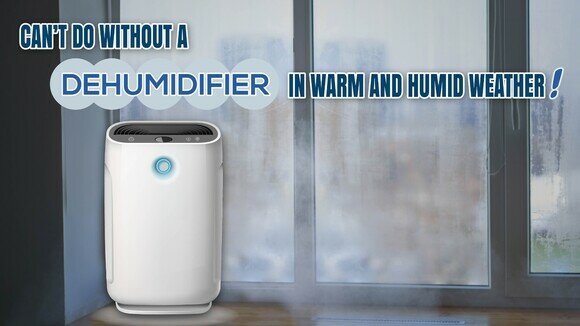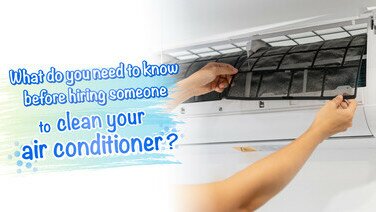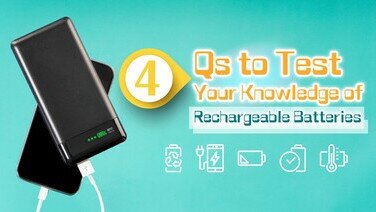At present, most dehumidifiers on the market are compressor-type dehumidifiers while desiccant-type dehumidifiers have gradually been withdrawn from the market. In addition, there are 2-in-1 air purifying dehumidifiers which usually claim to remove particulate matter and formaldehyde.
The working principle of the compressor-type dehumidifier is using the compressor to propel and circulate the refrigerant between the evaporator and condenser. Moisture in the air (moisture in the air condenses, not the moist air) passing through the evaporator will condense into water droplets on the surface of the evaporator and drip down into the water tank. Then, the air will be discharged out of the radiating pipe, drier and warmer than before. Then, the air will be discharged out of the radiating pipe, drier and warmer than before.
Don’t trust the manufacturer's test environment; you should refer to the energy label
Usually there are two daily dehumidifying capacity values, one commonly found in energy labels and one in product promotion leaflets.
At present, compressor-type dehumidifiers sold in Hong Kong must bear the energy label specified in the Mandatory Energy Efficiency Labelling Scheme. The energy efficiency level on the label is calculated based on the energy efficiency, the rated dehumidification amount in a standard environment and other data provided by a certified laboratory in the test report submitted by the agent to the EMSD. It is mainly divided into 5 levels, with level 1 representing the highest energy efficiency and being most energy-saving among dehumidifiers with the same rated dehumidifying capacity. The amount of dehumidification given on the energy label is measured in the standard environment specified in the labelling scheme and is more objective.
The claimed dehumidifying capacity marked on the promotion leaflets are usually measured under the manufacturer's test environment (i.e. temperature 30°C and relative humidity 80%), and may not accurately reflect actual circumstances of use. Consumers should pay attention to the test temperature and humidity when referring to the daily dehumidification amount claimed on the promotion leaflet or product manual. It is not advisable to use the set of values measured under higher temperature and humidity for product comparison.
For example, the daily dehumidifying capacity of compressor-type dehumidifiers measured under higher temperature and humidity will be higher, which may mislead consumers into thinking that the performance of the product is better, yet failing to meet up to expectations during usage.
Dehumidifying Performance under the standard environment: the actual dehumidifying capacity may be lower than claimed
Under standard environment, does the actual daily dehumidifying capacity match the values of the Mandatory Energy Efficiency Labelling Scheme?
The test results showed that 6 models had a lower dehumidifying capacity than claimed. Some were only slightly lower by about 0.1% to 1.1%, while 1 was about 6.9% lower than its claimed value, but the difference was still within the 10% tolerance level which is acceptable under the scheme.
What is a inverter-type compressor dehumidifier?
Inverter-type compressor dehumidifiers can automatically adjust the speed within a certain range, while compressor dehumidifiers can only operate at the highest power consumption mode and cannot adjustthe speed. The inverter-type compressor dehumidifier will operate at a higher speed upon starting, and it will automatically reduce the speed when the indoor humidity reaches the preset relative humidity. The power consumption at low speed is lower than that at high speed, but the key is that the energy efficiency at lower speed is generally higher, so it can save energy.
No need to buy the model with highest dehumidifying capacity ? It is advisable to consider home environmental factors
Understand your actual need at home (在選購時) when choosing a product: if your home is large or you live close to the sea or in a humid district, or if you want quick dehumidification, consider models with stronger capacity, and vice versa. In addition, you can also consider whether you need to turn on the dehumidifier all year round at home, or whether there is a requirement for the dehumidifying speed. For example, users who do not require particularly high dehumidifying speed can consider cheaper and smaller models.
Air Purifying Performance varied significantly
Clean Air Delivery Rate (CADR)
This is a parameter that reflects the air purification ability of the air purifier, which refers to the speed at which the air purifier provides air without specific pollutants, and the higher the value, the faster the speed of purification of the pollutants, the better the purification capacity.
Removal of particulate matter:
Particulate matter refers to cigarette smoke, dust and pollen, etc. The CADR of the four 2-in-1 air purifying dehumidifiers were tested. Taking the results of removing cigarette smoke as an example, the slowest speed was 45.2FT3/min, while the highest speed was 133.7 FT3/min, that is, the sample with the highest purification speed could be up to 2 times faster.
Removal of formaldehyde:
All 4 models can reduce the concentration of formaldehyde, but the speed is quite slow, from 5.7 to 16.4 FT3/min. The GB/T standard is measured in cubic metres per hour, and the CADR of each sample in this unit is between 9.7 and 27.9 cubic metres per hour, which means the purification speed varied by 1. 9 times.
Easy to use
Other details to consider, such as ease of use, are also important points to note before purchase. Here is a brief list:
| Exterior design | Size | Whether it will occupy a lot of space, whether it can be stored when not in use, or whether it can only be placed in the corner of the living room. |
|---|---|---|
| Movable castors:
| Whether it is convenient for the user to move, for example, between the living room and bedroom. | |
Cover of air outlet: | If there is no cover for the upward air outlet, dust can easily fall into the air outlet when the dehumidifier is not in use. | |
| Daily usage | Control panel functions: | For example, can you preset the timer (preset the one-off time, not timer)to avoid operating for too long or forgetting to shut down. |
Extended hose: | Some models come with an extension hose that can be used to dehumidify wardrobes or shoe cabinets. | |
Water tank: | Pay attention to the capacity, whether it requires frequent emptying, the difficulty of assembly, and the design of the handle. | |
Other: | Indicator light, switches/buttons operations. | |
| Cleaning and maintenance | Easy assembly: | For two-in-one models with air purifiers, attention should be paid to whether it is easy to install and remove the HEPA filter and dust filter. |
Indicators: | Some models have a filter cleaning reminder, but it is also important to note that the filter of some models cannot be cleaned with water. | |
Costs in the long run: | The filter of two-in-one air purifying dehumidifiers has to be replaced in a timely manner, and the cost of replacing the filter in the long run should be considered; the filter must be cleaned and replaced in a timely manner; otherwise, the air purifying performance will be greatly reduced. |
After understanding the above points, let’s look at the actual tests! 【Issue 520 of "Choice" monthly magazine: First test of 2-in-1 dehumidifiers Air purification performance is uneven 5 dehumidifiers have outstanding performance(Chinese Only)】 See which model is right for you!






![[Baby Snacks Guide] Who Says Snacks Can’t Be Healthy?](/f/guide_detail/415742/376c212/bb%20snack.jpg)




